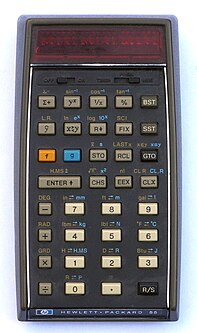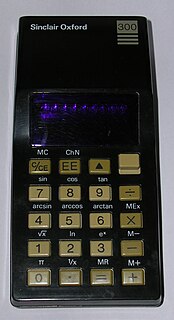 W
WA calculator watch is a digital watch with a built-in calculator, usually including buttons on the watch face. Calculator watches were first introduced in the 1970s and continue to be produced, despite falling from their peak popularity during the 1980s. The most dominant brands in the end was the Casio Databank series and Timex.
 W
WA digital camera is a camera that captures photographs in digital memory. Most cameras produced today are digital, and while there are still dedicated digital cameras, many more cameras are now incorporated into mobile devices like smartphones, which can, among many other purposes, use their cameras to initiate live video-telephony and directly edit and upload image to others. However, high-end, high-definition dedicated cameras are still commonly used by professionals and those who desire to take higher-quality photographs.
 W
WThe HP 2640A and other HP 264X models were block-mode "smart" and intelligent ASCII standard serial terminals produced by Hewlett-Packard using the Intel 8008 and 8080 microprocessors.
 W
WThe HP-55 was a programmable handheld calculator; a lower-cost alternative to the HP-65. Introduced by Hewlett-Packard in 1975, it featured twenty storage registers and room for 49 keystroke instructions. Its outward appearance was similar to the HP-65, but its silver band went through between the display and the keyboard like HP-45, its some key functions were different from HP-65 and it did not have a magnetic card reader/writer. Like all Hewlett-Packard calculators of the era and most since, the HP-55 used Reverse Polish Notation (RPN) and a four-level automatic operand stack.
 W
WThe IBM 5100 Portable Computer is a portable computer introduced in September 1975, six years before the IBM Personal Computer. It was the evolution of a prototype called the SCAMP that was developed at the IBM Palo Alto Scientific Center in 1973. In January 1978, IBM announced the IBM 5110, its larger cousin, and in February 1980 IBM announced the IBM 5120. The 5100 was withdrawn in March 1982.
 W
WLaser printing is an electrostatic digital printing process. It produces high-quality text and graphics by repeatedly passing a laser beam back and forth over a negatively charged cylinder called a "drum" to define a differentially charged image. The drum then selectively collects electrically charged powdered ink (toner), and transfers the image to paper, which is then heated in order to permanently fuse the text, imagery, or both, to the paper. As with digital photocopiers, laser printers employ a xerographic printing process. Laser printing differs from traditional xerography as implemented in analog photocopiers in that in the latter, the image is formed by reflecting light off an existing document onto the exposed drum.
 W
WLYS-16 was an early microcomputer based on the IMP-16 making it one of the first 16 bit microcomputers. It was designed and made by members of the Lysator academic computer club at Linköping University, Sweden
 W
WThe MOS Technology 6502 is an 8-bit microprocessor that was designed by a small team led by Chuck Peddle for MOS Technology. The design team had formerly worked at Motorola on the Motorola 6800 project; the 6502 is essentially a simplified, less expensive and faster version of that design.
 W
WThe 6507 is an 8-bit microprocessor from MOS Technology, Inc. It is a version of their 6502 packaged in a 28-pin DIP, which makes it cheaper to package and integrate in systems. The reduction in pin count is achieved by reducing the address bus from 16 bits to 13 and removing a number of other pins used only for certain applications.
 W
WThe Stadsgewestelijk Materieel or SGM is an electric multiple unit (EMU) train type operated by the Dutch railway company Nederlandse Spoorwegen. They were built from 1975 to 1983 by Talbot.
 W
WSinclair Oxford was a range of low-cost scientific calculators manufactured and sold by Sinclair Radionics in England from 1975 until 1976.
 W
WThe Sphere I was a personal computer completed in 1975 by Michael Donald Wise and Monroe Tyler of Sphere Corporation, of Bountiful, Utah. The Sphere I featured a Motorola 6800 CPU, onboard ROM, a full-sized CRT monitor, 4 KB of RAM, and a keyboard with a numeric keypad.
 W
WThe VT50 was a CRT-based computer terminal introduced by Digital Equipment Corporation (DEC) in July 1974. It provided a display with 12 rows and 80 columns of upper-case text, and used an expanded set of control characters and forward-only scrolling based on the earlier VT05. DEC documentation of the era refers to the terminals as the DECscope, a name that was otherwise almost never seen.